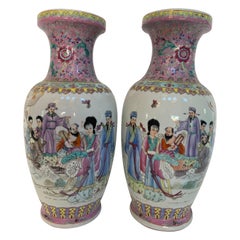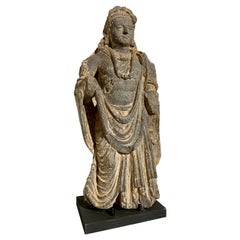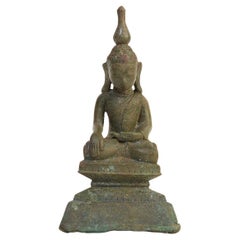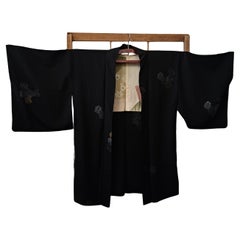Antiquities
to
627
884
423
2,093
14
7
10
7
6
4
4
4
4
2
2
1
1
1
1
1
1
1
1
794
639
660
21
308
77
68
38
3
17
11
7
17
8
9
18
3
704
550
497
281
230
1,873
1,329
727
400
376
2,114
2,111
2,111
10
4
3
3
2
Antiquities For Sale
Big Pair of Chinese Hand Painted Porcelain Vase
Located in Brea, CA
Pair of antique 20th century Chinese hand painted porcelain vase. One has rim short light hair line inside, outside no hair line, s...
Category
1960s Chinese Art Deco Vintage Antiquities
Materials
Porcelain
Gandharan Standing Bodhisattva Maitreya, Carved Black Schist, 2nd-4th Century
Located in Austin, TX
An impressive and well carved Gandharan figure of the Bodhisattva Maitreya, the Buddha of the Future, carved black schist, ancient Kingdom of Gand...
Category
15th Century and Earlier Pakistani Antique Antiquities
Materials
Schist
16th Century, Shan, Antique Burmese Bronze Seated Buddha
Located in Sampantawong, TH
Antique Burmese bronze Buddha sitting in Mara Vijaya (calling the earth to witness) posture on a base.
Age: Burma, Shan Period, 16th Century
Size: Height 16.3 C.M. / Width 8.6 C.M.
...
Category
16th Century Burmese Antique Antiquities
Materials
Bronze
$680 Sale Price
20% Off
19th Century Chinese Bamboo Opium Pipe
Located in Atlanta, GA
An opium pipe is a pipe designed specifically for the vaporization and inhalation of opium. But these beautiful little antiques have become one-of-a-kind works of art.
This late 19th...
Category
Late 19th Century Chinese Antique Antiquities
Materials
Brass
Japanese silk jacket HAORI black with gold pattern
Located in Paris, FR
This is a silk jacket which was made in Japan.
It was made in Showa era around 1980s.
The haori is a traditional Japanese hip- or thigh-length jacket worn over a kimono. Resembling ...
Category
Late 20th Century Japanese Showa Antiquities
Materials
Silk
Pomegranate Shaped Copper Red Glazed Vase, Yuan-Ming Period
Located in seoul, KR
This piece is a small ceramic vessel with a distinctive silhouette modeled after a pomegranate, notable for its full, well-balanced curves. The mouth, reminiscent of the fruit’s caly...
Category
16th Century Hong Kong Ming Antique Antiquities
Materials
Copper
$1,500 Sale Price
25% Off
Ancient Islamic Persian Khurasan Silver Inlaid Bronze Caligraphy Inkwell 1200
Located in Portland, OR
An important Islamic Khurasan bronze and silver-inlaid inkwell & cover, Eastern Persia, Circa 1200.
The inkwell of cylindrical form and having a shallow dome top cover with a tall knopped finial and inlaid with a twin band of scrolled silver. The base of the dome and the rim of the cover having bands on interlaced silver inlay, the inkwell having three loop handles.
The body of the inkwell having two bands of silver inlaid Naskh script, between the bands are twin panels...
Category
15th Century and Earlier Persian Islamic Antique Antiquities
Materials
Silver, Bronze
Indian Antique Smelting Pot with Back Handle, Front Spout and Weathered Patina
Located in Yonkers, NY
An Indian antique smelting pot from the 19th century, with back handle, front spout and nice patina. Created in India during the 19th century, th...
Category
19th Century Indian Antique Antiquities
Materials
Iron
Porcelain Japanese Circular Blue and White Box with Cover
Located in Oklahoma City, OK
Beautiful round porcelain dish or circular box with a cover in blue and white. This circular chinoiserie box with a cover is finely decorated with a crisp blue and white hue. This di...
Category
20th Century Japanese Chinoiserie Antiquities
Materials
Ceramic, Porcelain
$4,800 Sale Price
20% Off
Bactrian Bronze Age Marble Column Idol
Located in Vosselaar, BE
Bactrian marble column idol, circa 3000-2000 BC. It has an elegant tapering form with a undeep groove running on the top. The colomn has incrustation on the side where it laid on the...
Category
15th Century and Earlier Afghan Archaistic Antique Antiquities
Materials
Marble
Gandharan Terracotta Figure of the Bodhisattva Maitreya, 4th-6th Century
Located in Austin, TX
A very rare and decidedly charming half-scale terracotta sculpture of the bodhisattva Maitreya, the Buddha of the Future, ancient region of Gandha...
Category
15th Century and Earlier Pakistani Antique Antiquities
Materials
Terracotta
Antique Terracotta Chinese Figures Statues
Located in Alessandria, Piemonte
Antique terracotta figures Han style from my private collection: collected about 35 years ago and never exibited to the public.
One is very ancient, the other one is more recent. The prices are different, but an expert can understand the value. A certificate Oxford test would be needed: I don't have it, so I'm accepting offers: I want to close my activities and I have a beautiful Chinese collection, see the other ones published under my name enrica pasino.
Category
15th Century and Earlier Chinese Han Antique Antiquities
Materials
Terracotta
$6,004 / set
Wooden Low Table, Japanese Antique, Wabi-Sabi, Mingei
Located in Katori-Shi, 12
This is an antique wooden low table from the Taisho period.
It was used as a workbench by a craftsman at the time, and although it is unclear which craftsman used it, there are smal...
Category
Early 20th Century Taisho Antiquities
Materials
Wood
Blue And White Yuan-style ‘Dragon’ Bottle Vase, Yuhuchunping, Early Qing dynasty
Located in seoul, KR
The vase is delicately potted featuring a pear-shaped body that rests on a slightly flared foot and extends upward into a trumpet-shaped neck. Its exterior showcases a dynamic, three-clawed dragon in stride amidst flames.
This piece reflects a similar style to Yuan dynasty Yuhuchunping dragon vases, while reinterpreting certain details, such as the sharp and simplified shape of the dragon's head, the distinctive straight design of its claws, and the intricate depiction of the dragon’s scales.
The sticker on the base indicates that the absolute age was determined through radiological mechanical appraisal using the quantum absolute dating method, with the results pointing to the early 18th century.
Period : Qing Dynasty(Presumably Kangxi or Yongzheng Period)
Type : Yuhuchunping
Medium : Blue and White glaze
Condition : Excellent(slight salt residue remains on the surface, and the glaze is worn primarily around the edges, such as mouth and base)
Provenance: Southeast Asia, South China Sea from Shipwreck in early 2000s
Reference :
1) Christies Hong Kong 26 SEP 2024 - Lot 2
(Price realised : 819,000 HKD / Type : related)
* Yuan-Ming Style from Qing Dynasty
During the Qing dynasty, many ceramics were produced that imitated the styles of the Ming and Yuan dynasties. This practice was not mere imitation but a creative endeavor to inherit and innovate upon past techniques and styles. Qing dynasty ceramicists mastered the exceptional techniques of Ming and Yuan ceramics and used them as a foundation to develop more advanced works. Particularly, Yuan dynasty blue and...
Category
Early 18th Century Vietnamese Qing Antique Antiquities
Materials
Porcelain
$11,250 Sale Price
25% Off
Extraordinary 18C Indian Bronze Goddess-Originally Part of Large Oil Lamp, 9721
Located in Ukiah, CA
Extraordinary solid cast Indian bronze goddess. Head to toe, the height is 9.25. Atop the custom base, the total height is 14 1/8". Very well sculpted and crisply cast. The custom st...
Category
Late 18th Century Antique Antiquities
Materials
Bronze
Japanese silk haori jacket black
Located in Paris, FR
This is a silk jacket which was made in Japan.
It was made in Showa era around 1990s.
This haori jacket has a family crest of MaruniChigaiTakanoHaMon.
The haori is a traditional Ja...
Category
Late 20th Century Japanese Showa Antiquities
Materials
Silk
17th Century Arrowheads Excavated from Central Highlands, Vietnam (price for 1)
Located in Chicago, IL
17th century arrowheads excavated from central highlands, Vietnam. Beautiful patina on the arrowheads. Mounted
$1,400 each.
8.5" H x 5.5" W x 2" D
Category
17th Century Vietnamese Antique Antiquities
Materials
Metal
ANTIQUE SOLiD BRONZE JAPANESE KOI CARP STATUE OF A WONDERFULLY ELEGANT FISH
Located in West Sussex, Pulborough
Royal House Antiques
Royal House Antiques is delighted to offer for sale this absolutely stunning circa 1920 solid bronze Japanese Koi Carp statue
A wonderfully original find, this...
Category
Early 20th Century Japanese Japonisme Antiquities
Materials
Bronze
Antique Aesthetic Movement Anglo Japanese Dinner Gong 19th Century
Located in London, GB
A superb quality Aesthetic Movement Anglo-Japanese dinner gong in the manner of Edward William Godwin, Circa 1880 in date.
This fabulous gong is...
Category
1880s Antique Antiquities
Materials
Other
Jin Dynasty Cizhou Ware Crouching Tiger Pottery Pillow, 12th-century, China
Located in Brooklyn, NY
Chinese Jin Dynasty 12th Century Cizhou Ware Crouching Tiger Pottery Pillow .Tiger pillow, Jin dynasty, 12th century (circa 1150)
The pillow is assembled ...
Category
15th Century and Earlier Chinese Ming Antique Antiquities
Materials
Ceramic
Large Early Tang Dynasty Painted Pottery Model of a Prancing Horse, TL Tested
Located in Austin, TX
A magnificent and large early Tang dynasty (618-906 AD) model of a prancing or dancing horse, circa 7th century.
The majestic animal is caught mid-motion, one leg raised, head grace...
Category
15th Century and Earlier Chinese Tang Antique Antiquities
Materials
Pottery
Japanese Tansu, Wabi-sabi, 1920s, Japan
Located in Tokyo, Tokyo
The unique antique tansu — an elegant piece of furniture with deep Japanese roots.
This small tansu features six compartments that are not only functional but also serve as a work o...
Category
Early 20th Century Japanese Arts and Crafts Antiquities
Materials
Wood
Early 20th Century, Showa, Japanese Bronze Vase
Located in Sampantawong, TH
Japanese bronze vase.
Age: Japan, Showa Period, Early 20th century
Size: Height 40.2 C.M. / Width 27.5 C.M.
Condition: Nice condition overall.
Category
Early 20th Century Japanese Antiquities
Materials
Bronze
$1,200 Sale Price
20% Off
Pre-Khmer Pottery Pouring Vessel, Kendi, 6th-8th Century, Cambodia
Located in Austin, TX
An evocative large pottery pouring vessel, kendi, pre-Khmer, 6th-8th century, Cambodia.
The large kendi of typical form, with a bulbous body set on a...
Category
15th Century and Earlier Cambodian Antique Antiquities
Materials
Pottery
Antique Japanese chestnut flower stand, Wabi-Sabi, Japandi
Located in Katori-Shi, 12
This antique stand made of ash wood has a modest yet beautiful presence.
The combination of the rustic tabletop and the delicately turned lathe legs is impressive.
This flower stand ...
Category
Early 20th Century Japanese Taisho Antiquities
Materials
Wood
19th Century antique Chinese Tea Table Lacquered with Porcelain inclusions
Located in BILBAO, ES
Chinese black lacquerd tea table with gilt highlights, circa 1930's.
Needs restauration in left side, but the design and style is precious because it reunites black lacquered with a...
Category
19th Century Chinese Chinese Export Antique Antiquities
Materials
Bentwood
A Longquan Celadon-Glazed 'Dragon' Dish, Yuan Dynasty
Located in seoul, KR
The dish is decorated to the centre with a moulded appliqué dragon chasing the flaming pearl surrounded by a carved stylised foliage band at the cavetto. The moulded fluted exterior ...
Category
15th Century and Earlier Hong Kong Ming Antique Antiquities
Materials
Celadon
$5,925 Sale Price
25% Off
19th Century Chinese Bamboo Opium Pipe
Located in Atlanta, GA
An opium pipe is a pipe designed specifically for the vaporization and inhalation of opium. But these beautiful little antiques have become one-of-a-kind works of art.
This late 19th...
Category
Late 19th Century Chinese Antique Antiquities
Materials
Brass
Japanese Antique Tree Bump / Object Flower Stand /1968-1912s Primitive Wabi-Sabi
Located in Iwate-gun Shizukuishi-cho, Iwate Prefecture
This is an old Japanese tree bump.
You can put it on a sideboard or shelf and decorate it as an object.
Also, there is a hole in the middle, so I think you...
Category
Late 19th Century Japanese Meiji Antique Antiquities
Materials
Wood
$392 Sale Price
60% Off
Dutch Silver Plate Trinket Box Casket 1930 Hallmark
Located in Potters Bar, GB
Dutch silver plate trinket box and cover
Circa 1930
This pretty piece is embossed with figures and animals
We can ship to anywhere in the wor...
Category
1930s Vintage Antiquities
Materials
Silver Plate
Antique Bronze Vase Cloisonné Japan Meiji 19th Century Japanese
Located in Amsterdam, Noord Holland
Absolute top Quality vase with superb decoration of flowers
Cloisonné is a way of enamelling an object, (typically made of copper) whereby fine wires are used to delineate the dec...
Category
19th Century Japanese Meiji Antique Antiquities
Materials
Porcelain
$1,439 Sale Price
20% Off
Rare Annamese Stoneware Bowls with Brown-Green Glaze, Vietnam, 14th–15th Century
Located in seoul, KR
This finely matched pair of Annamese stoneware bowls exemplifies the refined ceramic artistry of Đại Việt (medieval Vietnam) during the 14th to 15th century. Each bowl is delicately ...
Category
15th Century and Earlier Vietnamese Antique Antiquities
Materials
Stoneware
$1,596 Sale Price / set
30% Off
A Rare Large Wucai Dragons and Phoenix Jar, Ming dynasty Longqing Emperor
Located in seoul, KR
The blue dragon and the red dragon are depicted in dynamic postures, each extending its claws to grasp a ruyi pearl (如意珠). The phoenix is adorned with flowing feathers and delicate c...
Category
16th Century Hong Kong Ming Antique Antiquities
Materials
Ceramic
$10,500 Sale Price
30% Off
15th Century Lao Buddha in the a Delightful Lanna/Laos Folk Style, 7590
Located in Ukiah, CA
15th century Lao Buddha in the a delightful Lanna/Laos folk style. Loss of original base and finial plus one ear mostly replaced. Large at 15 inches tall, 1...
Category
15th Century and Earlier Laotian Antique Antiquities
Materials
Bronze
$2,173 Sale Price
26% Off
Japanese Silk Haori Jacket Colorful Polka-dots 1980s
Located in Paris, FR
This is a silk jacket which was made in Japan.
It was made in Showa era around 1980s.
The haori is a traditional Japanese hip- or thigh-length jacket worn over a kimono. Resembling ...
Category
1980s Japanese Showa Vintage Antiquities
Materials
Silk
Antique 19th Century Chinese Lacquer Sewing Box with the Stand
Located in Brea, CA
Antique 19th century Chinese lacquer sewing table with hand painted scenes and beautiful legs. Gilt export black lacquer all-over the tabl...
Category
Late 19th Century Chinese Qing Antique Antiquities
Materials
Lacquer
Ancient Anthropomorphic carved stone sculpture
Located in London, GB
A large ancient Timor stone ancestor carving from the Belu district of central Timor .
Category
15th Century and Earlier Timorese Antique Antiquities
Materials
Stone, Metal
Maneki Neko with Seven Deities of Happiness 1980s
Located in Paris, FR
Era: Showa (around 1980)
Material: porcelain
The maneki-neko is a common Japanese figurine which is often believed to bring good luck to the owner. ...
Category
1980s Japanese Showa Vintage Antiquities
Materials
Ceramic
Japanese Antique Men's Bleu Kimono FUJI Daikan Yokoyama 1980s
Located in Paris, FR
This is a men's silk Kimono.
On the back of this kimono, there is a design/motif of Fuji Mountain.
This M.Fuji is the painting which is inspired by an artist Daikan YOKOYAMA.
He is ...
Category
1980s Japanese Showa Vintage Antiquities
Materials
Silk
Important Chinese Ancient Bronze Money Tree, 25BC-220AD
Located in South Burlington, VT
China, Ancient Bronze “Money Tree” Yaoqian Shu with original pottery base, Han dynasty (25 BCE – 220 CE)
Dimensions: 155cm, 62 inches high
A sculpted terracotta pottery base in the form of a tortoise with attendants and inserted with five individual bronze pole segments with twenty four individual hanging bronze open work money “branches” attached in tiers, four per tier and topped with a figure of a bronze phoenix as apex most bearing varying degrees of malachite and azurite encrustation from ancient burial.
Important Description Details:
Pottery "tortoise" base: 14.5" high and 11" wide
Bronze sections:
7pcs pole bronze sections approximately 8" length each
1pc top "phoenix" bronze section approximately 7" high and 6" wide
20 pcs long bronze hanging wings approximately 10" long and 5" wide each
4 pcs short bronze hanging wings (near top) approximately 7" long and 4" wide each
Total 32 pcs with ancient green and blue azurite patina.
Catalog reference: Schneible Fine arts catalog - 35 Years Collecting Treasures- Number 11p. 28 (see photos)
Provenance: Provenance: Private family collection formerly exhibited “Asia Week” New York City, Fuller Building, Zabriskie Gallery, 2008.
History of money trees:
In the late Han Dynasty tombs...
Category
15th Century and Earlier Chinese Han Antique Antiquities
Materials
Bronze
$100,000 Sale Price
33% Off
A Sealed 3.88CT Rare Natural Burma RUBY, Antique Oval Faceted Cut Loose Gemstone
Located in Wembley, GB
A Sealed 3.88ct Natural Rare Burma Ruby, in the Oval Faceted cut. Comes with the AIG Certificate.
Natural Myanmar Ruby.
Category
Early 1800s Burmese Primitive Antique Antiquities
Materials
Multi-gemstone
$4,985 Sale Price
20% Off
Yuan Dynasty, Antique Chinese Green Glazed Pottery Covered Jar
Located in Sampantawong, TH
Chinese green glazed pottery covered jar.
Age: China, Yuan Dynasty, A.D. 1271 - 1368
Size: height 35 cm / width 25 cm.
Condition: Wel...
Category
15th Century and Earlier Chinese Antique Antiquities
Materials
Pottery
$1,560 Sale Price
20% Off
Japanese Antique Chestnut wood sliding door cabinet , Wabi Sabi, Japandi
Located in Katori-Shi, 12
A sideboard with a strong presence, made with generous amounts of chestnut wood.
The main frame is made with a sophisticated joint called kendome. The chamfered design of the vertic...
Category
Early 20th Century Japanese Taisho Antiquities
Materials
Wood
Traditional Japanese Inro box with five compartments
Located in Autonomous City Buenos Aires, CABA
Traditional Japanese Inro Box with Five Compartments
Traditional Japanese inro box with five compartments. Classic design with dark lacquer and gold ...
Category
20th Century Japanese Japonisme Antiquities
Materials
Wood
Chinese yellow glazed porcelain vase, 19th c.
Located in New York, NY
incised with floral motif
Category
Late 19th Century Chinese Antique Antiquities
Materials
Porcelain
GOOD MELLOW LIMITED05, Japanese Antique side table, Wabi Sabi, Japandi
Located in Katori-Shi, 12
This series is based on the extremely popular antique coffee table that is hard to find and sells out quickly when it arrives.
The ash wood is finished with an oil coating.
This tab...
Category
2010s Japanese Taisho Antiquities
Materials
Wood
Rare Antique Qing Dynasty Chinese Gilt Silver Filigree And Enamel Brise Fan
Located in Brea, CA
Rare Fine Antique early 19th century Chinese gilt silver filigree and enamel brise fan , Qing dynasty, the fan has 22 sticks with a 18k gold ring loop , wond...
Category
Early 19th Century Chinese Qing Antique Antiquities
Materials
Silver, Enamel
Japanese silk jacket HAORI black with flower and lion pattern
Located in Paris, FR
This is a silk jacket which was made in Japan.
It was made in Showa era around 1980s.
The haori is a traditional Japanese hip- or thigh-length jacket worn over a kimono. Resembling ...
Category
Late 20th Century Japanese Showa Antiquities
Materials
Silk
Antique Traditional Indonesian Gong and bonang
Located in Milano, IT
This extraordinary piece of art from Southeast Asia exudes an ancient charm that transcends time, telling stories of distant traditions and cultures. Dating back to the late 19th century, this work is a testament to the skill and dedication of the artisans of that era, who infused life and soul into every detail.
The gong, the undisputed protagonist of this composition, is made of copper and features a dark patina that accentuates its antique and mystical character. This aged surface, which softens its original shine, adds depth and mystery, almost whispering the stories and rituals for which it was used.
Supporting the gong is a solid wooden structure, painted in a lacquered red that, despite the marks of time, retains a timeless beauty. The traces of wear reveal layers of underlying color, giving the piece a lived-in and authentic charm, as if it had witnessed countless ceremonies and sacred moments.
Alongside the main gong, two small gongs...
Category
Early 19th Century Indonesian Chinese Export Antique Antiquities
Materials
Metal, Copper
Striking multi-technique work by Robert Natkin - 9397
Located in Ukiah, CA
Striking multi-media work by Robert Natkin. From a large collection of Natkin's works from his early and middle periods. Not examined outside the frame. Glazed with museum glass. Thi...
Category
21st Century and Contemporary Antiquities
Materials
Paper
$3,560 Sale Price
20% Off
15 Auspicious Korean Traditional Embroidered Pillows
Located in seoul, KR
15 traditional embroidered pillows usually given by a bride to her husband as part of her dowry during marriage in Korea's modern era. These embroideries feature traditional symbols ...
Category
19th Century Korean Antique Antiquities
Materials
Fabric
$2,080 Sale Price / set
35% Off
Chinese Qin Dynasty Style Life-Size Kneeling Terracotta Soldier Statue
Located in Queens, NY
Chinese Qin Dynasty-style (20th Century) life-size terracotta soldier statue kneeling on a rectangular base. (Head is removable)(Companion piece: NW...
Category
20th Century Chinese Chinese Export Antiquities
Materials
Terracotta
A boxwood netsuke depicting a snake
Located in Milano, IT
Boxwood netsuke depicting a snake coiled around itself.
Signature engraved under the base.
Origin: Japan
Period: Meiji late 19th century.
Dimensions: 4 x 3.5 x 2 cm.
State of co...
Category
19th Century Japonisme Antique Antiquities
Materials
Boxwood
$1,729 Sale Price
20% Off
Chinese huanghuali cabinet, 17th c.
Located in New York, NY
provenance: Sotheby's (please refer to the pics); Because of the material that this cabinet is made out of, it may be the case that it cannot be shipped to an international address. ...
Category
17th Century Chinese Antique Antiquities
Materials
Wood
19th Century, Antique Thai Wooden Animal Rabbit
Located in Sampantawong, TH
Antique Thai wooden rabbit.
Age: Thailand, 19th Century
Size: Length 52 C.M. / Width 19 C.M. / Height 20 C.M.
Condition: Nice condition overall (some expected degradation due to its...
Category
19th Century Thai Antique Antiquities
Materials
Wood
$960 Sale Price
20% Off
Chinese multicolor porcelain vase, 19th c.
Located in New York, NY
wooden base is not included with this lot; continuous figural scene
Category
Mid-19th Century Chinese Antique Antiquities
Materials
Porcelain
Japanese Antique Cabinets, Wabi Sabi, Japandi
Located in Katori-Shi, 12
This is a beautiful cabinet that evokes the atmosphere of the Taisho period.
It is made of lauan and cedar.
It is finished with persimmon tannins and soot, which bring out the text...
Category
Early 20th Century Japanese Taisho Antiquities
Materials
Wood
Antique Fine Carved Chinese Hong Mu or Mahogany three Drawer Qing Altar Table
Located in Casteren, NL
This elegant Altar table was made in the Chinese Shanxi period and dates approximately 1850.
It is well constructed using mortise and tenon joinery techniques as was common on thes...
Category
Mid-19th Century Chinese Qing Antique Antiquities
Materials
Mahogany
$5,140 Sale Price
20% Off
Old Tibetan Conch Trumpet Horn
Located in Schellebelle, BE
Exceptional Old Tibetan Conch Shell Trumpet horn,
decorated with a Silver cover and semi-precious Stones Turquoise and Coral,
good old patina and w...
Category
1930s Tibetan Vintage Antiquities
Materials
Silver
Japanese Antique Lacquer Hair Comb with Flowers in Gold Maki-e
Located in New York, NY
Stunning antique Japanese lacquer hair comb with a geometric petal-like background of stylized chrysanthemums and flowers done in gold and red maki-e. Possibly Edo or Meiji time peri...
Category
Mid-19th Century Japanese Antique Antiquities
Materials
Giltwood, Lacquer
Recently Viewed
View AllMore Ways To Browse
Large Chinese Celadon Pots
Antique Slingshot
Bactrian Idol
Gandharan Schist
Geisha Pillow
Han Dynasty Bowl
Khmer Torso
Ancient Luristan Bronze
Chinese Terracotta Army Warriors
Cloisonne Pots Bonsai Trees
Greco Bactrian
Han Dynasty Amphora
Han Dynasty Court Lady
Palanquin Handles
Sancai Phoenix
Schist Gandharan Buddha
Bactrian Stone
Chinese Coconut Cup





